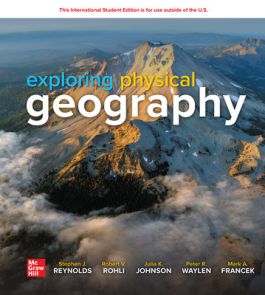Exploring Physical Geography: 2024 Release ISE
1266186433
·
9781266186431
Exploring Physical Geography promotes inquiry and science as an active process. It encourages student curiosity and aims to activate existing student knowledge. One way this is done is by employing a learning-cycle approach where students’ explorat…
Read More
1. The Nature of Physical Geography
2. Atmospheric Energy and Matter
3. Atmospheric Motion
4. Atmospheric Moisture
5. Weather Systems and Severe Weather
6. Atmosphere - Ocean - Cryosphere Interactions
7. World Climates
8. Water Resources
9. Understanding Landscapes
10. Plate Tectonics and Regional Features
11. Volcanoes, Deformation, and Earthquakes
12. Weathering and Mass Wasting
13. Streams and Flooding
14. Glaciers and Glacial Landforms
15. Coasts and Changing Sea Levels
16. Soils
17. Ecosystems and Biogeochemical Cycles
18. Biomes
2. Atmospheric Energy and Matter
3. Atmospheric Motion
4. Atmospheric Moisture
5. Weather Systems and Severe Weather
6. Atmosphere - Ocean - Cryosphere Interactions
7. World Climates
8. Water Resources
9. Understanding Landscapes
10. Plate Tectonics and Regional Features
11. Volcanoes, Deformation, and Earthquakes
12. Weathering and Mass Wasting
13. Streams and Flooding
14. Glaciers and Glacial Landforms
15. Coasts and Changing Sea Levels
16. Soils
17. Ecosystems and Biogeochemical Cycles
18. Biomes
Exploring Physical Geography promotes inquiry and science as an active process. It encourages student curiosity and aims to activate existing student knowledge. One way this is done is by employing a learning-cycle approach where students’ exploration precedes the introduction of geographic terms and the application of knowledge to a new situation. Another method used is to ensure every concept is covered within two pages allowing students to complete a topic in a short interval of time. This text also contains a wealth of figures to take advantage of the visual and spatial nature of geography and the efficiency of conveying geographic concepts.

